(61393 products available)













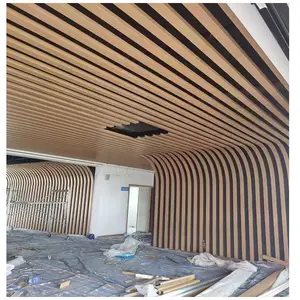
































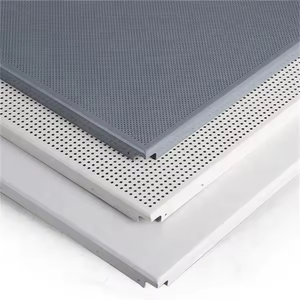
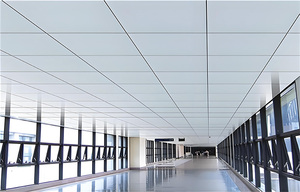

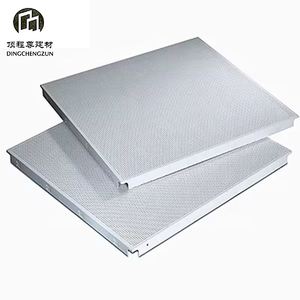
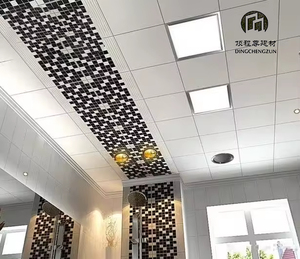
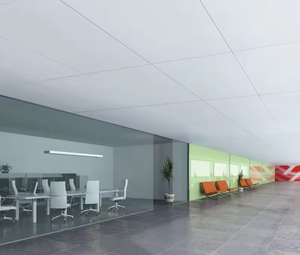
























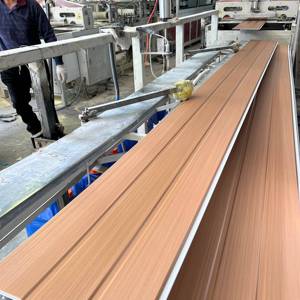

















































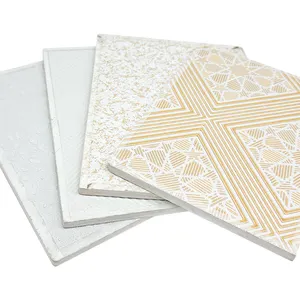









































































































A perforated ceiling is a ceiling that has tiny holes, or perforations, in it. These holes are used for different things. Some types of perforated ceilings are:
Acoustic ceiling tiles - These ceiling tiles are made from materials like mineral fiber, fiberglass, or fabric. The tiles fit into a grid system attached to the ceiling. The tiles with holes help control sound in buildings. They make rooms with good hearing for talking and presentations. The tiles absorb echoes and make the acoustics sound better.
Metal ceiling tiles - These ceiling tiles are made from metal like aluminum or steel. They are placed on the ceiling as individual tiles. The tiles have different designs with patterns of holes. The metal tiles reflect sound waves and give the ceilings a unique look. They are also easy to keep clean.
Perforated wood panels - These panels are made from wood like oak or pine. The panels have patterns of small holes on the surface. The panels are attached directly to the ceiling without tiles. They absorb sound and add warmth to the room. The wood panels also make the ceiling look nice and natural.
Gypsum board - Gypsum board is also called drywall. It is made from gypsum plaster pressed between cardboard. The board has small holes punched in it. The board is hung from the ceiling using metal studs. The perforated drywall helps control sound and is easy to install. It is also painted any color for aesthetics.
Fabric stretched ceilings - A fabric ceiling has tiny holes woven into the material. The fabric is stretched tightly across a frame attached to the ceiling. These ceilings look sleek and modern. They also absorb sound waves and reduce echoes.
Drop ceilings - Drop ceilings, also called suspended ceilings, are made of tiles with small holes. The ceiling is hung down lower than the real ceiling using metal grids. The tiles with holes help reduce sound and control echoes in the room. They are also easy to take out and replace.
Perforated metal ceilings are made from strong materials such as steel, aluminum, or tiles with small holes. These holes are evenly spread out, making patterns or designs that look pretty. Sometimes, there are little dots or lines around the holes. The ceiling is painted white or other colors so it can blend in better.
Perforated ceilings are used in offices, schools, stores, airports, factories, and more. Let's look at some of their features and functions.
Acoustic Performance
The primary function of a perforated ceiling is to reduce noise levels. It helps to minimize echoes and sounds, making a space quieter. Spaces that are not too loud are more comfortable.
Improved Airflow
The holes in a perforated ceiling allow air to flow through easily. This air circulation helps keep the room cool without using too much energy. It is a more efficient way to ventilate and regulate temperature.
Enhances Aesthetics
Perforated ceilings look very nice. Their patterns and designs give the room a modern style and beauty. They make the ceiling interesting to look at and improve the overall appearance of the building.
Conceals Wiring and Ducts
Perforated ceilings hide ducts, pipes, and wiring that run along the ceiling. This gives the ceiling a clean look without any clutter. It makes the space seem well organized and neat.
Flexibility and Customization
Perforated ceilings can be made from different materials and with different hole sizes. They can be adapted for specific needs and designed how one wants them to look. This customization allows for greater flexibility.
Light Diffusion
Some perforated ceilings are designed to spread light evenly. This makes the room brighter without having harsh, glaring lights.
Fire Resistance
Perforated ceilings are made with fire-resistant materials. They help slow down the spread of fire and give people more time to get out safely.
Ease of Installation and Maintenance
These ceilings are simple to install and take care of. If one part is damaged, it is easy to replace just that section without doing the whole ceiling.
Sustainability
Many perforated ceilings are made from recycled materials. They can also be recycled again when one is done using them. This helps the environment.
Perforated ceilings are used in various industries and applications. The use of a ceiling with holes is common in commercial spaces and other environments where sound management, aesthetics, and air circulation are prioritized. Here are some common usage scenarios:
Offices
Perforated ceiling tiles are used in office spaces. They help control sound and make the offices look nice. The holes in the tiles can be different sizes and shapes, which makes the office environment pleasant and professional. The tiles also make the office work better by reducing echoes and background noise. This is important for when people have meetings or talk to each other.
Schools
Schools use ceilings with small holes in them to manage noise levels in classrooms and auditoriums. These ceilings are visually appealing and improve learning environments. They are also useful in gymnasiums and libraries.
Hospitals
Perforated ceilings are found in hospitals. They are clean and help control noise in places like patient rooms, operating rooms, and hallways. These ceilings make the hospital environment look better. They also make it easier for doctors and nurses to do their jobs.
Retail Stores
Retail stores use perforated ceilings to manage sound and improve lighting. The holes in the ceiling can be used to hang lights that make the store brighter. A brighter store attracts more customers. The perforations also allow air to move freely, keeping the store at a comfortable temperature.
Hospitality
Hotels, restaurants, and cafes use ceilings with holes in them for sound control and to make the space look nice. In restaurants and cafes, these ceilings help reduce noise from customers talking and dishes clattering. This creates a more pleasant environment. In hotels, the ceilings add to the elegance of the place.
Industrial Settings
Factories and workshops use perforated ceilings to control noise levels and improve ventilation. The holes in the ceilings allow air to circulate and keep the space cool. This is important when machines are working and producing a lot of heat. Managing temperature is important for safety and efficiency.
Theaters and auditoriums
These spaces use ceilings with holes in them to control sound and improve lighting. The perforated ceilings help ensure that sound from the stage travels well to the audience. This makes for better plays, concerts, and presentations. The ceilings also help direct sound and prevent echoes. This is important in spaces where many people are sitting together.
There are a number of things designers need to consider before settling on a specific type of ceiling. Below are some of them.
Functionality
The first step in choosing a perforated ceiling is to determine its intended purpose. Is it for an office, commercial space, a theater, or a home? Each space has unique acoustic and aesthetic requirements that influence the type of ceiling to be selected. For instance, a theater may require a ceiling with high sound absorption properties. On the other hand, a commercial space may prioritize visual appeal over acoustic properties.
Material
Perforated ceilings are made from different materials, including metal, wood, and acoustic tiles. Each material has its own benefits and drawbacks. Acoustic tiles are affordable and easy to install. They are also available in many designs and patterns. Metals, on the other hand, are durable and offer high-performance sound. They provide a modern aesthetic. When choosing the material, consider factors such as budget and lifespan.
Design and Aesthetics
The perforation pattern plays a major role in determining the design and performance of the ceiling. Round, square, and custom patterns are the most common types of perforations. Round perforations are the most common. They offer a balance between aesthetics and acoustic performance. Square perforations provide a modern and clean look. They are effective in sound diffusion. Custom patterns allow for creativity and design uniqueness. Choose a pattern that complements the overall design of the space.
Acoustic Properties
Perforated ceilings are designed specifically to enhance the acoustics of a room. This is done by controlling sound absorption and transmission. Consider the desired acoustic properties when choosing a perforated ceiling. These include sound absorption, sound transmission, and noise reduction.
Maintenance
Maintenance requirements are often overlooked when choosing a ceiling. However, they are an important factor that impacts long-term costs and convenience. Some perforated ceilings require regular cleaning and maintenance. Others may need professional assistance for the same reason. Take into account the maintenance level that the space can afford.
Regulatory Requirements
Perforated ceilings are subject to building codes. These include fire safety, environmental impact, and health regulations. These regulations differ according to the country. Therefore, it is important to take into account the regulatory requirements when choosing a ceiling to ensure compliance and safety.
Q: What is a ceiling tile with holes called?
A: Acoustic panels, sound-absorbing panels, or perforated ceiling tiles are the names given to ceiling tiles with holes.
Q: What are the disadvantages of a dropped ceiling?
A: The following are some of the drawbacks of a dropped ceiling: Dropped ceilings can be costly and time-consuming to install. They will not work in every room, particularly those with slanted ceilings. A suspended ceiling will reduce the height of a room. There will be limited height reduction, but it will still be noticeable. The loss of height can be a problem in rooms that are already not very high. For example, if a room's ceiling is 8 feet high and a suspended ceiling is installed that is 1 foot high, the room will only be 7 feet high. People will see how low the ceiling is, and it can make the room feel cramped.
Q: What are the two types of ceiling tiles?
A: There are two main types of ceiling tiles: solid and perforated ceiling tiles. Solid ceiling tiles are flat and without holes. In contrast, perforated ceiling tiles have patterns of holes or dots throughout. Both types can add style and function.
Q: Are ceiling tiles better than drywall?
A: Ceiling tiles are better than drywall in certain situations. For example, if someone wishes to install a new ceiling quickly without needing a lot of time, suspended ceiling tiles are a better choice. Ceiling tiles will also be more convenient if users want to make changes later on.